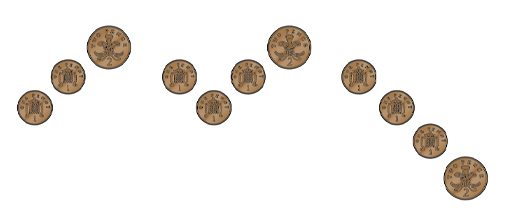1.4 Melodic contour
Using descriptive words or visually representing the broader movement within a melody using arrows or symbols might indicate how a melody is constructed. Exploring the overall shape of a melody – or melodic contour – in further detail may reveal additional insights, such as the highest or lowest point of the melody, and approximately how the overall pitches included in the melody relate to each other. We can make a simple visual representation using coins or buttons to represent the approximate pitch of individual notes. Figure 5 shows an example using opening of the chorus from The Beatles song Penny Lane. Here larger coins have been used to represent longer notes, and there is increased space between the longer and shorter notes to give an approximate indication of how these might appear rhythmically.
Activity 5
Gather some coins, buttons or similar items which enable you to create a visual representation of a melodic contour. Then listen to Audio 5, Getting Better by The Beatles. Create a visual representation of the first line of the chorus, which sets the lyrics ‘I’ve got to admit it’s getting better / A little better all the time’. You can hear these lyrics starting at c.00:16 on Audio 5. Use a coin to represent each of the syllables in the lyrics (represented in Figure 6 below) and so eighteen coins are used in total.
‘I’ve got to ad-mit it’s get-ting be-tter / A lit-tle be-etter all the time’
Figure 6 Syllabic representation of an extract of the lyrics from The Beatles Getting Better
Creating a visual representation of the melodic contour will give you an idea of the overall shape of the melody at the start of the chorus. Think about where the melody rises and falls, and where it stays the same. Don’t worry if you make mistakes, your visual representation of the melodic contour is just to give you a sense of the overall shape.


